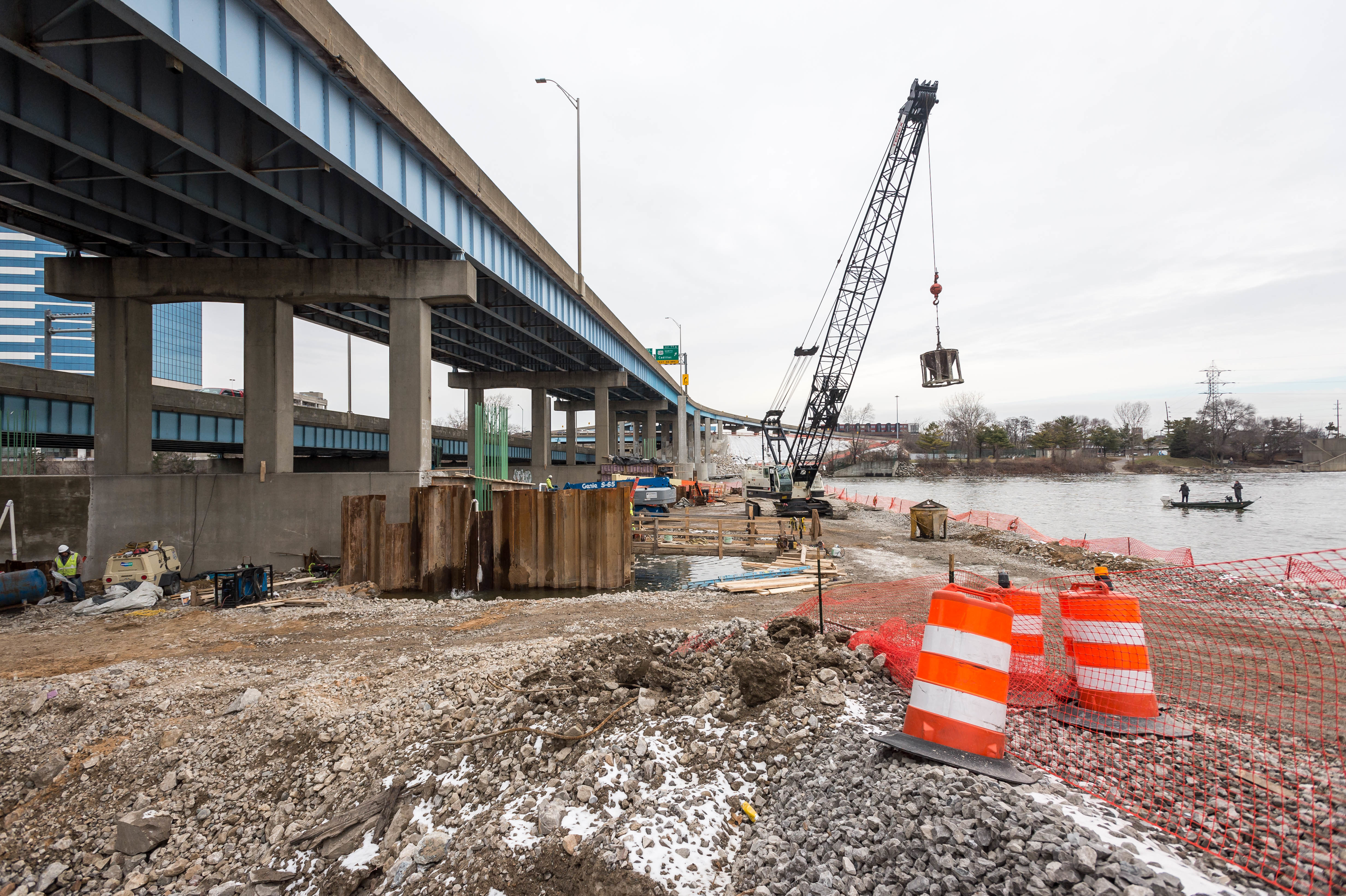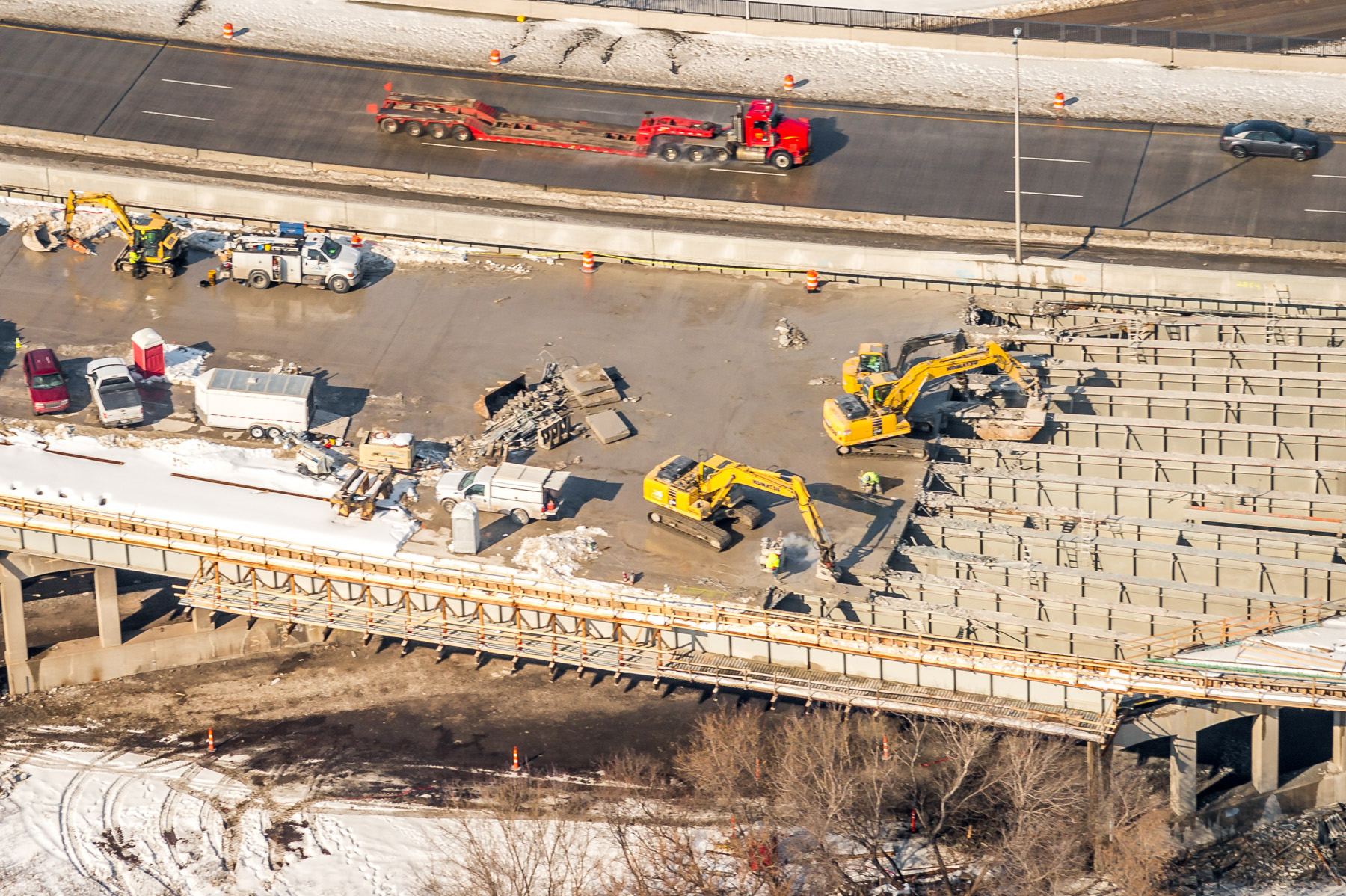Bridge work comes in all shapes and sizes for MDOT
Date Posted: March 9 2018
While local, county and state road crews have been hard at work across the state during our incredible 2018 winter pothole season, the Michigan Department of Transportation has also been undertaking some long-term projects on state roads.

TYING REINFORCING ROD to be used on a pier cap on a project at I-196 and Ottawa Avenue in downtown Grand Rapids are (l-r) Mark Miller and Chris Russell of Iron Workers Local 25. They’re employed by Black Swamp. The Michigan Department of Transportation is undertaking a lane expansion of the westbound bridge section, including new piers below. Photo credit:

THE BRIDGE WITH the largest concrete surface in Michigan – the I-75 Rouge River Bridge in Southwest Detroit – is in the midst of a complete deck rehabilitation as part of the overall I-75 Rouge River Detroit-Downriver Connection project. As bad as the condition of the deck had become, the bridge’s substructure, including piers and girders, will remain in use because of a good repair and maintenance regimen since the bridge was completed in 1967. Photo credit:
Among the largest: the $165 million in major repairs to the I-75 Rouge River Bridge in Detroit, and rehabilitation of the freeway bridges and pavement farther Downriver. And among the most interesting projects: the widening of the westbound I-196 bridge over the Grand River in Grand Rapids.
The I-196 bridge widening addresses a traffic bottleneck, and will increase the span's lanes from three to four. In 2010's "Fix of I-196" project, an extra lane was built on the westbound side approaching the bridge, but it ended at Ottawa Avenue. When work is complete on this project and the lane is added to the bridge, the lane will continue on to U.S. 131, just past the Grand River.
The work involves building a dry surface in the middle Grand River, which is shallow at that spot, in order to allow the placement of heavy equipment required by the project. "They basically placed clean, polished stones in the river under the bridge, to act as a platform for excavators and bulldozers and other heavy equipment," said MDOT spokesman John Richard.
He said there was mussel relocation as part of the project, as well as the maintenance of a path for fish to travel past. Piers will then be bolstered to support the bridge's added lane and shoulder. Bridge decking will be replaced. "You don't see something like this all the time, it's a really cool project, Richard said.
There are separate I-196 east and west spans over the Grand River at this point, but widening work is only taking place on the westbound bridge. Both spans were originally constructed in 1964. The prime contractor on this $15 million project is Anlaan Corp. Completion is expected in October 2019.
Road work on a larger scale is taking place along I-75 between southwest Detroit and Brownstown Twp. in the Downriver area. The I-75 Rouge River Detroit-Downriver Connection project began in early 2017, with the closure of southbound lanes and complete reconstruction of the pavement. This year, crews are similarly working on the northbound side, with northbound traffic switched to the new southbound lanes. Work is expected to continue until October 2018.
The project includes:
* Removing and replacing the concrete surface on the 1.63-mile-long I-75 Rouge River Bridge in southwest Detroit - the span with the largest concrete surface area in Michigan.
* Removing and replacing the concrete surface on the two Dearborn Street ramp bridges adjacent to the Rouge River Bridge, as well as at the Fort Street bridge just north of the Rouge River Bridge.
* Removing and replacing the bridges carrying I-75 over Goddard Road and a drain north of Goddard Road.
* Overhauling 13 other bridges along I-75 through the Downriver communities.
* Adding intelligent transportation system equipment, which includes electronic signs, cameras, and traffic information gathering equipment to help MDOT communicate to drivers about travel times, safety, and mobility issues.
* Pavement patching on northbound and southbound I-75 between the Rouge River and Goddard Road.
"We're doing very well, our prime contractor (C.A. Hull) and the crew specialize in bridge building, and they're all top-notch," said MDOT Project Engineer Bill Erben. "Problems come up, but we work through them. They know what they're doing." He said the maximum number of tradespeople on the project is 120.
In February 2017, the Michigan Department of Transportation closed the southbound lanes of the I-75 Rouge River Bridge and began a complete reconstruction of the bridge pavement. Erben said the trades have basically worked with the weather: during the colder months, concrete is cut into slabs and removed in an orderly fashion so as not to damage the bridge's underpinnings. In the warm weather, concrete pours are scheduled.
Erben said there have been few surprises on the bridge project as concrete removal has progressed. "Overall the steel underneath is quite structurally sound," Erben said. The bridge's steel box girders over the Rouge River are 10 feet deep - "very stout," he said. But girder sections that aren't over river are shorter - 24-36 inches. "Not as stout,"Erben said, "so we add steel plates where needed, and we anticipated that."
The entire I-75 rehabilitation project, and all the traffic headaches it has created for Downriver drivers, is slated for completion in October - or earlier.

TYING REINFORCING ROD to be used on a pier cap on a project at I-196 and Ottawa Avenue in downtown Grand Rapids are (l-r) Mark Miller and Chris Russell of Iron Workers Local 25. They’re employed by Black Swamp. The Michigan Department of Transportation is undertaking a lane expansion of the westbound bridge section, including new piers below. Photo credit:
Sara Martin/MDOT

THE BRIDGE WITH the largest concrete surface in Michigan – the I-75 Rouge River Bridge in Southwest Detroit – is in the midst of a complete deck rehabilitation as part of the overall I-75 Rouge River Detroit-Downriver Connection project. As bad as the condition of the deck had become, the bridge’s substructure, including piers and girders, will remain in use because of a good repair and maintenance regimen since the bridge was completed in 1967. Photo credit:
Jim Lemay/MDOT
